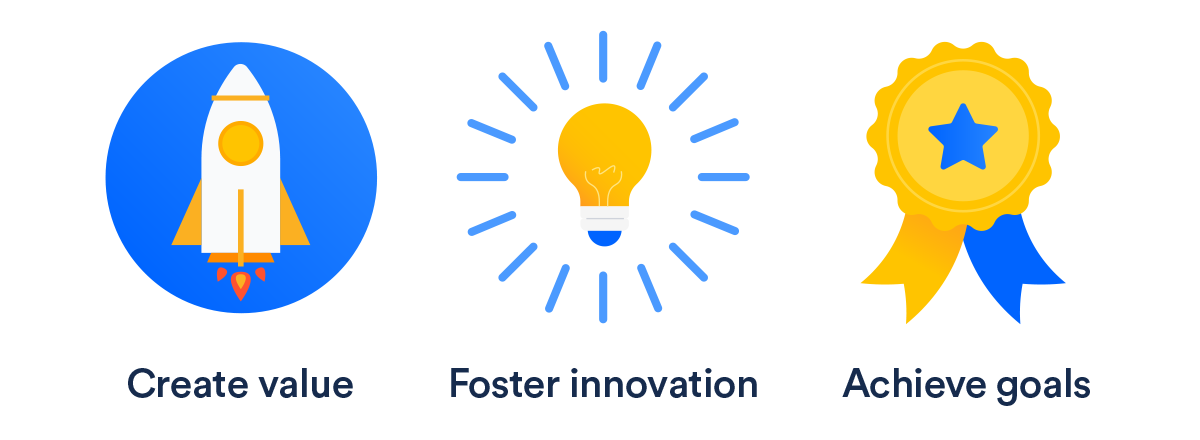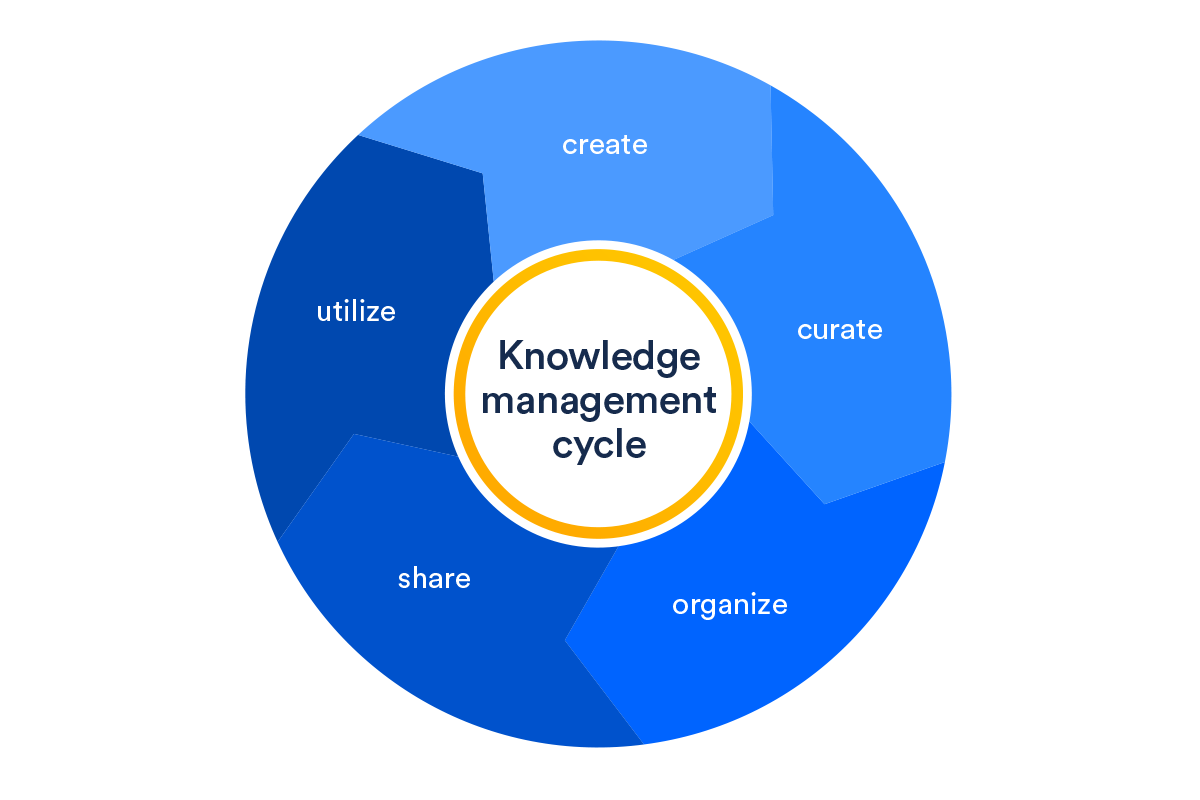Comment améliorer votre workflow de support informatique
What is knowledge management?
Knowledge management is the process of creating, curating, sharing, using, and managing knowledge across an organization and even across industries.
ITIL 4 explains that “knowledge management aims to ensure that stakeholders get the right information, in the proper format, at the right level, and at the correct time, according to their access level and other relevant policies. This requires a procedure for the acquisition of knowledge, including the development, capturing, and harvesting of unstructured knowledge, whether it is formal and documented or informal and tacit knowledge.” (ITIL 4, 5.1.4, Knowledge management).
A knowledge base is the foundation of a knowledge management practice. In IT, the knowledge base is a self-serve online library of information about a product, service, department, or topic. The data in your knowledge base can be from anywhere, but usually comes from several contributors who are well versed on the relevant subject. The knowledge base can include FAQs, troubleshooting guides, and any other details you may want or need to know.
We’ve all come to depend on search engines, which make knowledge management look effortless. They take advantage of a vast, internationally connected knowledge base (also known as the internet). You just enter a topic and get the information you need. For IT teams, knowledge management can be a complex undertaking, though the rewards are worth it.
What are the benefits of knowledge management?
With services becoming more complex, IT teams now have to keep up with the broad range of technologies and procedures needed to effectively support customers. This makes knowledge management more important than ever. Effective knowledge management harnesses the knowledge of people throughout your organization, and then easily shares that knowledge. You don’t lose any information when someone goes on vacation, gets sick, or leaves the company.
From a big-picture standpoint, it enables you to:

Create value. Get the right information to the right people at the right time.
Foster innovation. Use shared knowledge to inspire brainstorming, collaboration and big ideas.
Reach goals. Enable teams to set targets and actually hit them.
For organizations large and small, knowledge management puts content at the fingertips of those who develop and provide your products and services. This is a benefit on its own, but it also helps shorten development cycles for new initiatives; increases connectivity between internal and external personnel; enables more effective management of business environments; and leverages the intellectual capital and assets in your workforce.
Types of knowledge management
Knowledge management is a constant cycle of taking knowledge that's tacit or implicit, and enabling its availability in the form of explicit knowledge. That sounds complicated, so let's take a step back and understand the three different types of knowledge that exist.
Tacit knowledge is knowledge that stems from personal experience, context, or practice. This type of knowledge is stuck in your brain, making it hard to communicate to others. Since tacit knowledge is based on experience and intuition, like speaking another language, it's a huge competitive advantage and a huge challenge when implementing knowledge management systems.
Explicit knowledge is codified knowledge, or knowledge that has been documented and is easily accessible. Given its simple nature, explicit knowledge is much easier to store and retrieve in a knowledge management system. The challenge is ensuring it's reviewed and updated.
Implicit knowledge is embedded in process, routines, or organizational culture. It can exist in a formalized format, like a manual or written guidelines, but the knowledge itself isn't explicit. Instead, it often lives in the way an organization runs.
By understanding these three different types of knowledge, you have a better starting point for understanding how the knowledge within your company should be managed. When done the right way, it can help create value, foster innovation, and make it easier to achieve goals.
Knowledge management best practices
Knowledge is one of the IT organization's most valuable assets, and open knowledge sharing can help your team stay on the same page, collaborate, and make better, faster decisions. Open sharing makes knowledge more powerful, making information no longer an individual's knowledge, but the community's knowledge. To promote more open knowledge sharing, here are some best practices we recommend:
- Aggregate your team’s knowledge in a single repository or system. As workplace technology evolves, knowledge now exists in more and more disparate places—across email, tickets, and in the minds of individual team members. Though choosing the right technology is important, this is just one step in your broader knowledge management strategy.
- Increase transparency with open and shared information. Instead of keeping documents siloed in emails and folders, or locked behind permissions settings, invest in technology that connects and unifies knowledge. Knowledge should be easy for your entire organization to search, find, and create. Encourage team members to collaboratively edit pages, give feedback through inline comments, or at-mention teammates for peer review.
- Make work visible with a project poster. For every major initiative, create a project poster to share your goals and progress with the rest of the team and stakeholders. This is a living, accessible document that can help you explore your problem space, define your scope, and get feedback.
- Focus on brief articles or answers. Shared documentation does not always mean shared understanding. Rather than creating long, expansive documents, tailor your content to your team. Your entire team can learn and absorb information faster when it's quick to consume, uses easy-to-understand language, and published in a timely matter.
- Champion a culture of knowledge sharing. Reward top contributors with an ongoing recognition program that values both quality and quantity. Your leadership team can go a long way in setting a positive example by regularly contributing information like important organizational updates. They can also drive staff to your tool and use your tool to interact with teams directly.
Building a successful knowledge management strategy
Knowledge management is an ongoing responsibility. Even after you’ve implemented a system, there’s a constant cycle of adding new material and eliminating items that are outdated, as well as the discovery of hidden knowledge.

Here are the key steps to building a successful knowledge management strategy for your organization.
1. Identify your business situation and develop objectives and goals.
By first conducting an internal analysis of your organization, you’ll be able to align the knowledge management system with your goals.
2. Prepare your organization for implementation.
Acknowledge that this is a big deal. It’s going to require cultural changes.
3. Form a knowledge management team.
Might seem like a no-brainer, but you’d be surprised how often organizations forget this. The first step in implementing any new process is putting someone in charge.
4. Conduct a knowledge audit.
See what knowledge is buried, and where it’s buried. Find out what’s missing, and begin to set the stage for what you want to do. For tacit knowledge, this process requires observation, interviews, or surveying the experts.
5. Determine your technology needs and prioritize those needs.
Figure out what tools you’ll need to implement knowledge management. Plan for the costs now. It’ll be easier to incur them later.
6. Determine the key attributes and features of your knowledge management system.
Figure out what you want your system to look like. Then make a list. Make sure everything lines up internally––that the technology and scope will lead to the results and happy stakeholders you need. Not sure what to look for? Check out the next section for a few ideas.
7. Put everything you know in one place.
You have a lot of knowledge. But it’s everywhere. Aggregate your knowledge with a solution provider that provides a single repository, one that’s simple to use and easy to access. This knowledge base makes it easy for people throughout your organization to learn and to serve your customers. And makes life a lot easier for all involved.
8. Measure and improve your program.
Once you’ve launched your knowledge management practice, take time to step back and review. Measure what’s working and what isn’t. Adjust accordingly and update constantly. This will be an ongoing effort.
Choosing a knowledge management system
Great software makes knowledge management simple. So before you jump into implementation, ask yourself these questions about your technology:
- Does it promote and foster collaboration and communication?
- Can people label, share, and organize content?
- Can you customize it and add functionality?
- Is it flexible enough to adapt to changes?
- Does it handle migration seamlessly?
- Is it scalable for a growing organization?
- How secure will it keep your system?
- Does it enable measurement?
- Does it make navigation easy?
- How powerful is the search engine?
- Can it segment information into different projects, topics, etc.?
- Can it integrate with your existing software?
- Does it allow flexible permissions?
- Are there social media-style elements such as “liking” and “commenting?”
Aside from functionality, and most importantly, make sure your knowledge management system is needs-driven and solves for things like generating ideas and innovations, fostering a knowledge-sharing culture and community, enabling the discovery and building of expertise, and promoting feedback.
Summary
There is something in knowledge management for everyone. Whatever your business or market, people throughout your organization have valuable knowledge worth sharing. That’s true across departments. Whether IT, customer support, HR, legal, and even marketing or finance, all of these departments have knowledge that constantly needs to be shared with a team or a whole organization. With a plan in place, workers across disciplines and departments can access your company’s knowledge base to solve problems and prevent future ones.
Get better knowledge management with Jira Service Management.
Atlassian for ITSM
The basics you need to know about ITSM with Atlassian – across IT delivery, operations, and support, plus best practices and tips.
Get the guideBase de connaissances : votre solution pour améliorer la collaboration
Découvrez la puissance d'une base de connaissances pour votre entreprise. Augmentez la productivité, améliorez le service client et rationalisez efficacement la gestion des informations.
Read the article